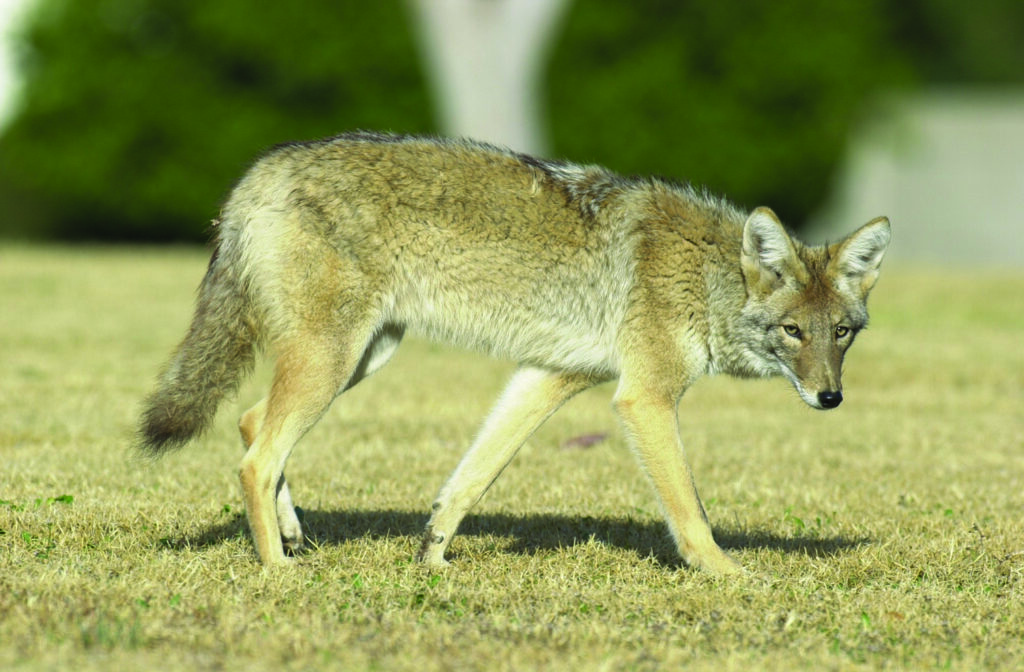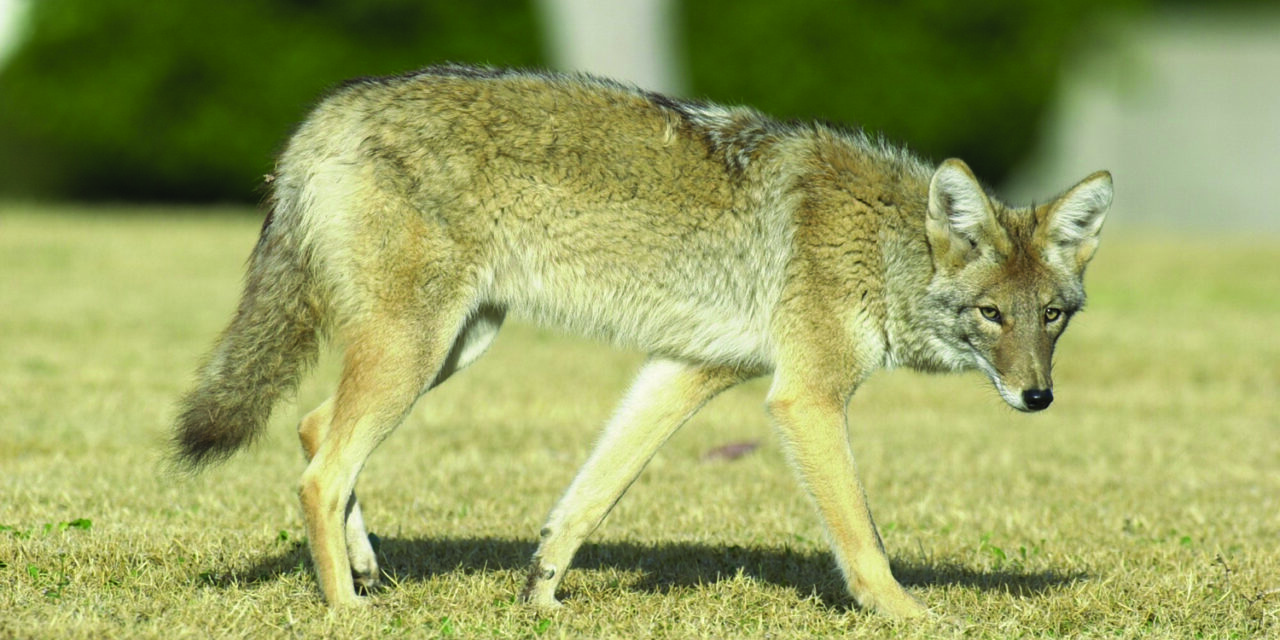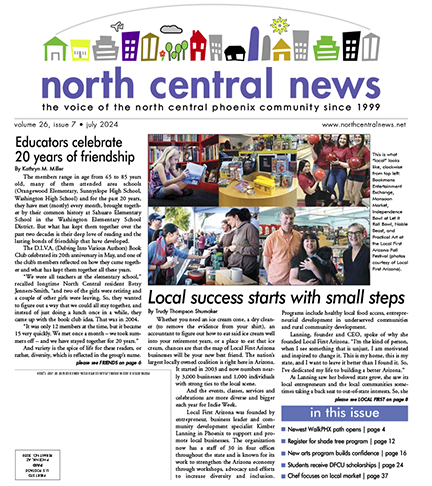
Coyotes are highly adaptable, and they are thriving in North Central Phoenix and other populated areas, according to urban wildlife experts (photo courtesy of Arizona Game and Fish).
Where’s the best place to get food and drink in your neighborhood? Just follow one of those coyotes you see trotting down your street. Haven’t seen one yet? You will. Just wait a minute or two.
The number of coyotes in North Central Phoenix is increasing, and the animals are getting bolder and bolder around people.
“Coyotes learn very quickly to find food sources. They are virtually anywhere there is food and water,” said Darren Julian, urban wildlife specialist with Arizona Game and Fish Department. “They are highly adaptable, and they are thriving in North Central Phoenix, as they are in all populated areas.”
Green lawns and other vegetation mean there is water in this otherwise desert environment, and coyotes know that. Add the small animals like rabbits, squirrels, foxes, cats and small dogs that usually hang out in neighborhoods, and they have everything they need to thrive.
“We’re getting more and more calls from Phoenix residents, asking for help with coyotes in their neighborhoods. The key is to stop providing food and water — they will move on,” said Julian.
“Well-intentioned animal lovers often leave food and water out for cats and dogs and that is an open invitation to coyotes. So are blocks of pressed seed for birds — often referred to ‘quail blocks.’ Irrigation and swimming pools provide water, and it’s the perfect habitat for coyotes.”
Julian emphasizes that the “coyote problem” cannot be solved by government agencies.
“We need residents to cooperate by not providing a friendly environment to them. As they become more and more comfortable, they are bolder around small children and small pets. That is a safety issue.”
Do whatever you can to make coyotes feel unwelcome in your yard and ask your neighbors to do the same.
“The best way to protect wildlife is to help them stay wild. If they become comfortable or even dependent on people, they create a safety risk to children and small pets. When that occurs, the wild animals are no longer safe,” said Julian.
Intentionally feeding wildlife, except birds and tree squirrels, is prohibited by state statute in Maricopa County. Violations can result in $300 fines. If feeding activity in your neighborhood is causing wildlife to become bold, call the 24/7 Operation Game Thief confidential tip hotline at 1-800-352-0700.
Here are some ways to make your home unfriendly to coyotes. Arizona Game and Fish Department provides more tips on its website.
- Know that coyotes can easily jump a six-foot block wall to enter what many homeowners think is the safety of a back yard. Security cameras often record a coyote casually browsing a patio for food.
- Don’t leave food and water outside for pets or feral cats. If you feed your pets outdoors, remove food and water after they eat and drink.
- Secure all pet doors, even if they are accessible only through a fenced yard. Julian says the best solution is to build a dog run with a secure top to keep your pets safe.
- Do you keep chickens in your yard? Build a secure run, similar to what he recommends for other pets. “Coyotes can get into what you think is a secure structure when they are going after a meal, so really secure it well with heavy wire,” he says.
- If you provide birds with quail blocks, put them up in a tree or on a pedestal, out of reach of coyotes and javelinas. Most of the blocks are made with molasses to hold the birdseed together, and the critters love the sweet stuff.
- Don’t leave pumpkins or other decorative foodstuff like squash and fruit where coyotes and javelina can find it.
- Secure garbage cans, and only put them out on collection days. Consider freezing food scraps until garbage collection day, because hungry coyotes will find them in garbage cans.
- Teach children to steer clear of wildlife. Well-fed coyotes look like dogs, but kids should be taught that they should never approach them.
- Where there is one coyote, there is usually a pack. Often one “scout” animal will appear to be alone, while its pack is lurking behind a bush or a wall, ready to take on whatever animal is lured by the scout.
- When you walk your small dog or other pet, keep it on a short leash and stay alert. If you do encounter a coyote, make loud, low-pitched noises like growls. “Don’t scream or yell — they may mistake those noises for prey, and you don’t want that,” advises Julian. “Also, throw your hands in the air and wave them. The idea is to intimidate them so they will run away. You cannot outrun a coyote. Don’t try, because when you run, you will invoke their predator response and they will show you how quickly they can take down their prey.”
- Consider carrying a powerful squirt gun filled with a 15 percent solution of household ammonia in water and send a stream their way. Julian advises that the ammonia will not harm the animal, but they will avoid the area after being sprayed.
- Pepper spray or bear spray are also good to carry as deterrents.
- Residents often trap and neuter feral cats, then release them back into the neighborhood. Coyotes are attracted to the cats, and the well-intentioned efforts to control a cat problem often create a coyote problem, advises Julian.
Julian sums up the issue: “We all want people and animals to be safe. We must work together to do that.”
Visit Arizona Game and Fish Department’s website at www.azgfd.com for more information about wildlife in urban areas.










































